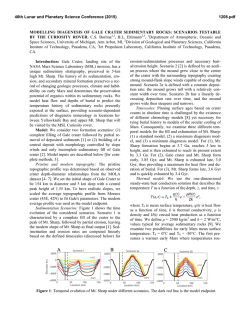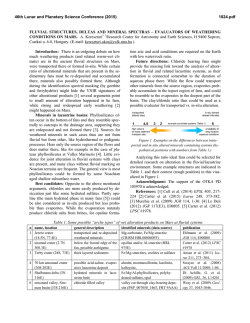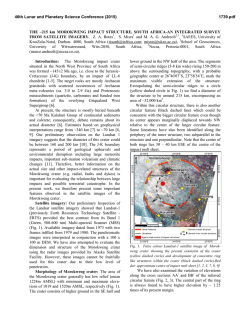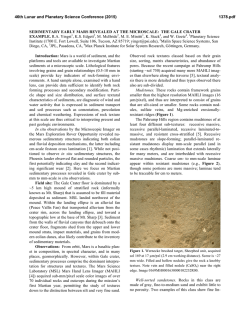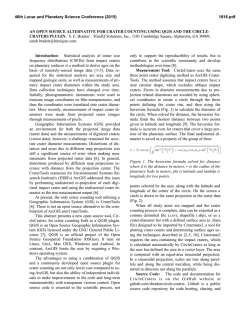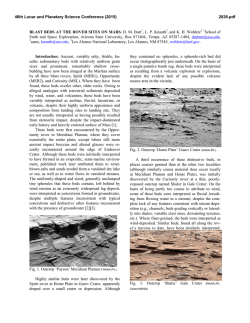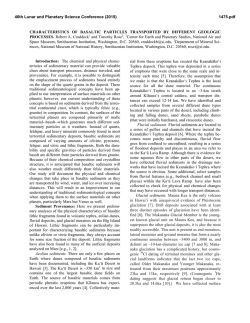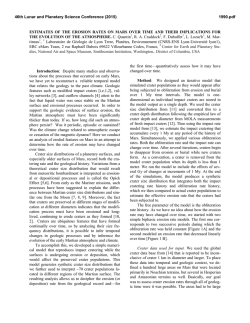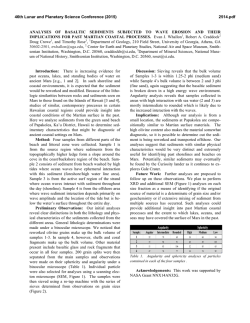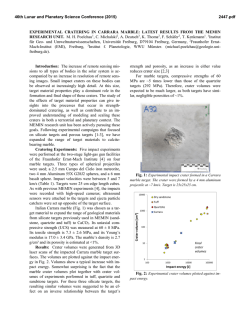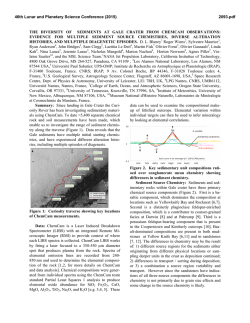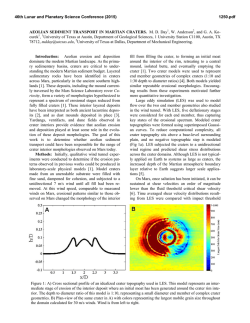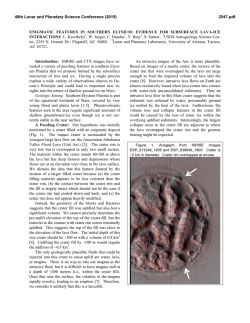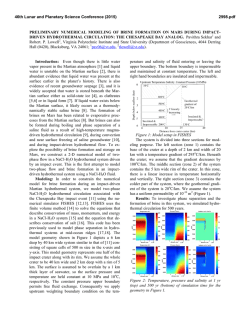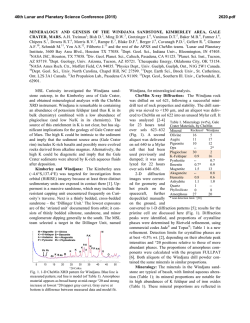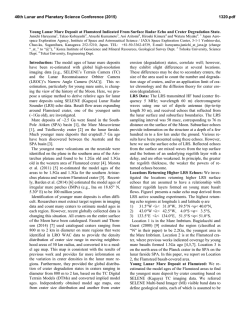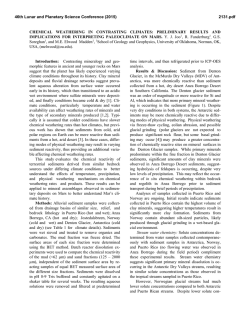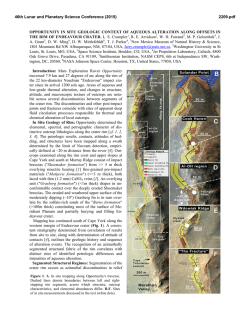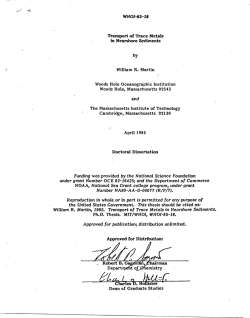
ANCIENT CLIMATE?
46th Lunar and Planetary Science Conference (2015) 2161.pdf WHAT CAN CURIOSITY'S STUDY OF GALE CRATER TELL US ABOUT MARS' ANCIENT CLIMATE? A. R. Vasavada1, J. P. Grotzinger2, S. Gupta3, R. M. Haberle4, M. A. Mischna1, M. I. Richardson5, R. C. Wiens6, 1Mail Stop 264-640, Jet Propulsion Laboratory, California Institute of Technology, Pasadena, CA, 91109, [email protected], 2Division of Geological and Planetary Sciences, California Institute of Technology, Pasadena, CA, 91125, 3Imperial College London, London, UK, 4Space Science and Astrobiology Division, NASA/Ames Research Center, Moffett Field, CA, 94035, 5Ashima Research, 600 S. Lake Ave, Suite #104, Pasadena, CA, 91109, 6Los Alamos National Laboratory, Los Alamos, NM, 87544. Introduction: NASA chose Gale Crater as the landing site for the Curiosity rover because it best offered the chance to assess potential habitable environments in Mars' early history [1]. Orbital observations revealed geological features on the crater rim, floor, and within the stratified central mound (Aeolis Mons, informally named "Mt. Sharp") that indicated fluvial and groundwater activity. Mineralogy expressed within lower Mt. Sharp suggested extensive water-rock interaction with varying chemistry [2]. Most importantly, these geological and mineralogical features are placed within the context of the (presently) closed basin of Gale Crater and the km-scale stratigraphy of Mt. Sharp, allowing the possibility of deriving temporal relationships and connections to regional or planetary processes, such as the ancient climate system. Here we discuss the implications of Curiosity's past results for Mars' paleoclimate and ideas for making further progress as the rover explores Mt. Sharp. Exploration of Yellowknife Bay: Curiosity's study of Yellowknife Bay in 2012-13 found evidence for an ancient lake and groundwater system [3]. Sediments sampled from the Sheepbed mudstone contained abundant phyllosilicates and other indications that near-neutral pH, low-salinity water had weathered basaltic sediments, and that this alteration was authigenic (occurred in place). The lack of evidence for chemical weathering of the sediments prior to deposition can be explained by the short transport distance from the crater rim (where the sediments presumably were derived from primary igneous rocks), arid conditions, and/or cold (but above-freezing) temperatures expected in the fluvio-lacustrine system [4]. Implications of the Yellowknife Bay findings for Mars' paleoclimate are complicated by two factors. First, using terrestrial analog sedimentation rates, the mudstones require only a few thousand years of liquid water [3]. Second, geological mapping has been unable to confidently place the Yellowknife Bay rocks into a temporal sequence with strata exposed on Mt. Sharp. These factors limit what can be learned from Yellownife Bay in terms of the persistence and timing of the wet climate. Formation of Mt. Sharp: In the latter half of Curiosity's nearly 15-month drive across Gale Crater's plains, the team began noting a pattern of southwarddipping, roughly east-west trending sandstone beds, interstratified between flat-lying sandstone and conglomerate beds. Similar sedimentary structures were seen as the rover headed southward and uphill. After extensive study, these structures are interpreted as stream and delta deposits with a transport direction toward the current (uphill) slope of Mt. Sharp. A model that the team currently employs proposes that when the fluvio-deltaic systems were active, the crater floor was a broad, closed basin (plus or minus a central uplift), and that sediment from the southward fluvial system and probably other sources progressively built the lower rock layers that now are exposed at the flanks of the mountain. In this model, the crater was partially filled with vertically stacked river, delta, and lake sediments. During this phase, the lake depth need not have been more than a few meters at any one time, and likely varied in areal extent and/or disappeared during dry intervals. Later undefined processes brought additional sediment to create the upper portions of the mountain and subsequently eroded the crater infill to its present, mound shape. Although it is still in the early stages of examination, this working model fits many of Curiosity's observations on the plains and made a prediction that, as the rover drove further southward, there would be a facies transition to flat-lying, fine-grained lacustrine deposits. In fall 2014, Curiosity reached the first rocks that are mapped as the Murray formation, the basal layer of Mt. Sharp. Examination of these sediments in a ~12 m section at the Pahrump Hills site found them to be flat-lying (although precise dip measurements are forthcoming) and predominantly fine-grained, but also stratified in beds varying in thickness (mm to cm) and interspersed with more erosion-resistant facies. The rhythmic nature of some of the finely laminated facies adds another dimension to the implications for paleoclimate. Geologic Constraints on Paleoclimate: Decades of orbiter imagery provide the bulk of geological data used to infer and constrain the ancient climate of Mars, such as the valley networks, evidence for paleolakes, deltas, and oceans, and mineralogy of ancient terrains. More recently, the Spirit and Opportunity rovers have 46th Lunar and Planetary Science Conference (2015) provided descriptions of the physical and chemical environments at their respective landing sites. Questions posed to the data include the setting, timing, and persistence of liquid water, and the magnitude and persistence of above-freezing temperatures. From a climate perspective, it is hoped that the observations will constrain required temperatures and help distinguish, for example, whether above-freezing temperatures were short-lived (102 to 105 yr) or longlived; secular or cyclic; regional or global; etc. Such constraints can help distinguish between potential climate forcing mechanisms such as secular atmospheric loss, transient impact-induced climates, and orbital/axial variations (all with greenhouse gases), as well as scenarios that produced globally warm, regionally warm, or primarily cold and wet conditions [5]. A key discriminator is whether the ancient climate had persistent rainfall, since such a hydrological cycle would require humidity supplied by open expanses of evaporating water. What Curiosity Can Contribute: Curiosity has the benefit of exploring a landing site where multiple environmental transitions are thought to have been recorded in the stratigraphy of Mt. Sharp. The putative lacustrine sediments at Pahrump Hills are several times as thick as those studied at Yellowknife Bay, requiring at least many thousands of years to accumulate. In the next year, Curiosity will continue to explore the Murray formation at Pahrump Hills and beyond, where another 100+ m of stratigraphic thickness are preserved. If fluvial, deltaic, and/or lacustrine sediments are present throughout the formation, the geologic constraint on the duration of liquid water could range to millions of years. It is hoped that the Murray formation will yield new constraints on the duration of fluvial and lacustrine activity, and whether it was continuous or episodic. Detailed study of sedimentary structures might indicate whether lakes were open or ice-covered, and whether the lake-forming eras were interspersed with drier times. Beyond the Murray formation lies the Hematite Ridge, a prominent landform with ferric oxide signatures in MRO-CRISM spectra. Next, Curiosity will reach strata that contain smectite clay mineral spectral signatures. In Curiosity's second extended mission, it may reach the final major unit within lower Mt. Sharp, where sulfate minerals are identified from orbit. Each of these transitions suggests a different fluid chemistry at least, and potentially records planetary-scale changes in the abundance of liquid water and its chemistry. Manganese enrichments in some sediments on Gale Crater's plains provide insight into the oxidizing capability of ancient fluids and atmosphere, as well [6]. 2161.pdf The understanding of what environmental conditions led to the formation of these minerals, when they formed relative to the deposition of the sediment, and the implications for the geological and climatic history of Mt. Sharp, await their detailed study. References: [1] Grotzinger, J. P. et al. (2012) Space Sci. Rev., 170, 5-56. [2] Milliken, R. E. et al. (2010) Geophys. Res. Lett., 37, L04201. [3] Grotzinger, J. P. et al. (2014) Science, 343, 1242777. [4] McLennan, S. M. et al. (2014) Science, 343, 1244734. [5] Haberle, R. M. (2014), 8th Intl. Conf. on Mars, #1270. [6] Lanza, N. L. et al. (2014), Geophys. Res. Lett., 41, 5755-5763.
© Copyright 2025
